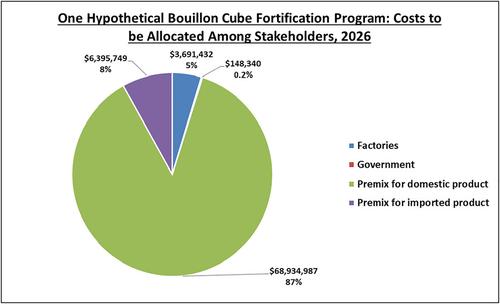当前位置:
X-MOL 学术
›
Ann. N. Y. Acad. Sci.
›
论文详情
Our official English website, www.x-mol.net, welcomes your
feedback! (Note: you will need to create a separate account there.)
The costs and the potential allocation of costs of bouillon fortification: The cases of Nigeria, Senegal, and Burkina Faso
Annals of the New York Academy of Sciences ( IF 4.1 ) Pub Date : 2024-10-21 , DOI: 10.1111/nyas.15234 Stephen A. Vosti, Michael Jarvis, Olufolakemi Mercy Anjorin, Reina Engle‐Stone, Maguette Beye, Faith Ishaya, Karim Koudougou, Blessing Oni, Hervé Somda, Katherine P. Adams
Annals of the New York Academy of Sciences ( IF 4.1 ) Pub Date : 2024-10-21 , DOI: 10.1111/nyas.15234 Stephen A. Vosti, Michael Jarvis, Olufolakemi Mercy Anjorin, Reina Engle‐Stone, Maguette Beye, Faith Ishaya, Karim Koudougou, Blessing Oni, Hervé Somda, Katherine P. Adams

|
Food and condiment fortification programs are needed to address micronutrient deficiencies and their health, developmental, and mortality consequences; but these programs are never free. Knowing program costs and their allocation across stakeholders is essential to design and manage effective, efficient, and sustainable programs. We developed 10‐year hypothetical bouillon fortification program cost models for Nigeria, Senegal, and Burkina Faso that included start‐up and operational costs for government and industry, as well as premix costs generated by an embedded premix cost calculator to allow for alternative premix formulas in cost calculations. The main drivers of total costs were total bouillon consumption and the types and amounts of fortificants in the micronutrient premix. For a premix that meets 30% of Codex Nutrient Reference Values in 2.5 g of bouillon for vitamin A, folate, vitamin B12, zinc, and iron, the cost per metric ton of fortified bouillon was ∼$325 for all countries (∼$0.01 per 2.5 g serving). Annual start‐up costs ranged from ∼$324k (Burkina Faso) to ∼$455k (Nigeria); nonpremix annual operating costs ranged from ∼$108k (Burkina Faso) to ∼$3.9m (Nigeria); and annual premix costs varied from ∼$2.4m (Burkina Faso) to ∼$76m (Nigeria). In policy discussions, program costs should be set alongside nutritional benefits.
中文翻译:

肉汤强化的成本和潜在成本分配:尼日利亚、塞内加尔和布基纳法索的案例
需要食品和调味品强化计划来解决微量营养素缺乏及其健康、发育和死亡后果;但这些程序从来都不是免费的。了解项目成本及其在利益相关者之间的分配对于设计和管理有效、高效和可持续的项目至关重要。我们为尼日利亚、塞内加尔和布基纳法索开发了 10 年假设的肉汤强化计划成本模型,其中包括政府和行业的启动和运营成本,以及由嵌入式预混料成本计算器生成的预混料成本,以允许在成本计算中使用替代预混料公式。总成本的主要驱动因素是肉汤总消耗量以及微量营养素预混料中强化剂的类型和数量。对于 2.5 克肉汤中维生素 A、叶酸、维生素 B12、锌和铁含量达到 30% 法典营养参考值的预混料,所有国家每公吨强化肉汤的成本约为 325 美元(每 2.5 克份量约为 0.01 美元)。每年的启动成本从 ∼$324k(布基纳法索)到 ∼$455k(尼日利亚)不等;非预混料年度运营成本从 ∼$108k(布基纳法索)到 ∼$3.9m(尼日利亚)不等;年度预混料成本从 ∼$2.4m(布基纳法索)到 ∼$76m(尼日利亚)不等。在政策讨论中,计划成本应与营养效益一起确定。
更新日期:2024-10-21
中文翻译:

肉汤强化的成本和潜在成本分配:尼日利亚、塞内加尔和布基纳法索的案例
需要食品和调味品强化计划来解决微量营养素缺乏及其健康、发育和死亡后果;但这些程序从来都不是免费的。了解项目成本及其在利益相关者之间的分配对于设计和管理有效、高效和可持续的项目至关重要。我们为尼日利亚、塞内加尔和布基纳法索开发了 10 年假设的肉汤强化计划成本模型,其中包括政府和行业的启动和运营成本,以及由嵌入式预混料成本计算器生成的预混料成本,以允许在成本计算中使用替代预混料公式。总成本的主要驱动因素是肉汤总消耗量以及微量营养素预混料中强化剂的类型和数量。对于 2.5 克肉汤中维生素 A、叶酸、维生素 B12、锌和铁含量达到 30% 法典营养参考值的预混料,所有国家每公吨强化肉汤的成本约为 325 美元(每 2.5 克份量约为 0.01 美元)。每年的启动成本从 ∼$324k(布基纳法索)到 ∼$455k(尼日利亚)不等;非预混料年度运营成本从 ∼$108k(布基纳法索)到 ∼$3.9m(尼日利亚)不等;年度预混料成本从 ∼$2.4m(布基纳法索)到 ∼$76m(尼日利亚)不等。在政策讨论中,计划成本应与营养效益一起确定。


















































 京公网安备 11010802027423号
京公网安备 11010802027423号